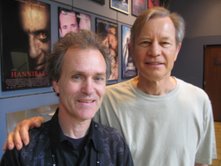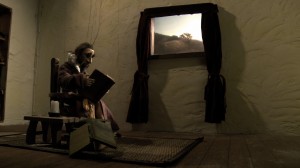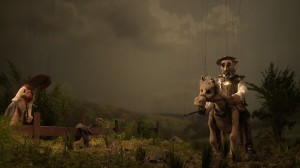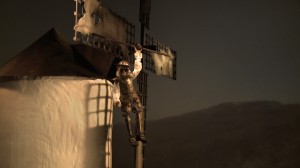Seasonal Newsletter from CLASSICS IN MINIATURE
Fall Nov. 2009 Vol. 1
Beauty is a primeval phenomenon, which itself never makes its appearance, but the reflection of which is visible in a thousand different utterances of the creative mind, and is as various as nature herself.
Puppetry ARTS…is a personal, creative art more known in the population of children than in adults. Because of this aspect Puppetry is rarely taken seriously as an mature arm form. But Puppetry has been around for a long time—as long as People have been around. Today Puppetry thrives as an art form that can not only live within the greater, more defined worlds of Fine Arts, Theatre Arts, Film and Television, in Developmental Psychology, but it can also find a place to reside within most every other communicative discipline.
Puppets are tools through which the Human Spirit can communicate.
Puppets break through cultural barriers, age barriers, and language barriers, they are used to excite and motivate (as team mascots and in political demonstrations), they can be used to educate the public concerning Public Health (STD’s) and other more sensitive issues, and they can be seen as key to progress within a therapeutic context for children and adults, and they can sell and do PR. It is for these reasons I believe Puppetry has a place at the table in the institutions of lower and higher education.
 Steven Ritz-Barr and Michael York at Sound Recording for film QUIXOTE.
Steven Ritz-Barr and Michael York at Sound Recording for film QUIXOTE.
Mr. York is the voice of Don Quixote. Other voice actors include, Gino Compagna as Sancho, Illiana Carter as the neice, Lynda Lester as the maid, Conrad Bishop as Maesa Pedro the Puppeteer, Brooks Elms as the Master Sheepherder, with Ritz-Barr as the beaten boy, Mike Simpson and Hoku Uchiyama as the 2 Merchants.
THE MAKING OF “QUIXOTE” by Steven Ritz-Barr

Journal entry Nov. 1, 2009
Cervantes’s book called Don Quixote will be just called QUIXOTE for this film. Since the last journal entry the film’s photography has been completed. We searched for actor’s who could be the voices of these characters. In a stroke of good fortune, Michael York accepted the role of Don Quixote. In mid October we recorded his voice, along with my friend Gino Campagna as the voice of Sancho, in a sound studio within the film dept. at UCLA. I am poised to record the remaining 9 voices at present. I still don’t know when a release date for the DVD will materialize or a launch date because there are so many factors to navigate. Now that Quixote has a great actor’s interpretation for the main role, the other parts of the production must measure up to that standard. So the sound FXs and the music, and the final image edit must all be as good as it can be. I target the end of 2009 for termination of the First Draft. This can then be critiqued and the formal launch can come in March sometime. Because I always think I will get just one shot at doing something right (which is not true in the film biz.) and because the limited finances for this internally developed film dictate the progress to some extent, it makes it hard to predict when it will be actually available to the general public as a DVD. This DVD will have the 30 min. Quixote film, along with English language voices and Spanish subtitles. There will be a visual piece about the Making of the Film, complete with photos of the early stages of the puppets, the sets, and the shooting. I hope to include a short section on Cervantes and the Cinema by Dr. Howard Mancing, (a leading Cervantes scholar from Purdue University), and Mass Giorgino, (Cervantes doctoral student and musician from Purdue).
Journal entry July 4, 2009
 The week of June 23, 2009 began the official pre-production phase of QUIXOTE, the next film in the Classics in miniature series. Up till now, the puppet of Quixote, Sancho, horse, donkey, and Innkeeper have been completed. The script was done. In regard to the Production, the minimum amount of money has been defined that we can spend on the piece. By the way, in the future,I will post some photos of the work we are accomplishing.
The week of June 23, 2009 began the official pre-production phase of QUIXOTE, the next film in the Classics in miniature series. Up till now, the puppet of Quixote, Sancho, horse, donkey, and Innkeeper have been completed. The script was done. In regard to the Production, the minimum amount of money has been defined that we can spend on the piece. By the way, in the future,I will post some photos of the work we are accomplishing.
The first few days were spend finalizing the script. It was noted the script read more like a human script than a puppet script. This means that the movements written into the script were easy for humans to do, but difficult for our suspended fragile marionettes to accomplish. I had eliminated the Quixote death scene because in our abridged version, we couldn’t pull it off without a downer impact at the end. We agreed quickly on a final version and moved on, noting some of the difficulties we may have with several scenes. We did not tarry on the script. It stayed essentially intact from the original, although it certainly got better with the scrutiny of the team. The first week ended on high note but apprehensive one because we didn’t know how we were going to accomplish shooting this script we liked. The next week began with many questions… First thing to solve was how we were to shoot the backgrounds. Since the story takes place outdoors in vast areas of endless landscape the backgrounds were a challenge. We listed possible ways to do them: outside shoot, overhead projector with projected painted scenes, overhead projector with ‘photo-shopped’ photos, painted backdrops, glass paintings, green screen shots to be composited later on, different fabrics, an ‘artsy’ succession of cardboard plains as in Dante’s Inferno (another puppet film), or any variations on these ideas. We tried many. We realized to test these ideas with our available home HD camera was not going to give us the trusted results. We also realized that tests in our home were not going to be adequate for determining results either, unless we were to conclude we would shoot it at the home, which would be far from ideal due to many factors—too tight a space for correctly operating the puppets. I decided to purchase our HD camera, a Sony EX1. We could do the tests with truthful accuracy and shoot the film and do reshoots if needed. Owning the camera would also mean committing a little more to the project. This was a difficult decision but one I committed to. It was the most expensive investment in the project. A stroke of luck followed this decision. We were offered a space for 2 months to work in—in a large home in Encino Hills, a friend named Dr. Robert Scheitzl was off to vienna for 2 months and we could use his home. It was big enough for what we needed and we set up shop there immediately. All we had to do was feed the cats and water the plants. Wow. We proceeded with the background tests. The photo-shopped photos of the actual terrain in La Mancha photocopied on acetate by Kinkos, projected from my simple overhead projector worked the best. I got that projector for $25 on Ebay 5 years ago, now it would come in handy. The technique is called rear-screen projection. We were very happy especially because it gave a ‘realism’ to the style. Next test was to incorporate the floor or earth with our scenes. So we made some mock trees, some dirt and raised plains that could transition into the far away background. This worked fine too. Placing plants in the foreground ‘sold’ the shots. But we discovered we would need more lights for the foreground—another expense. This is how we ended the week, satisfied yet still apprehensive about some major things—like how are the 4 puppeteers going to sit on the ‘bridge’ to operate the puppet. We set a plan for Monday to complete the tests before the official breakdown of the shoot would be completed. END
Journal entry May 27. 2009
 One of the things that makes DON QUIXOTE such a hard story to recreate is that the novel is so complex and apparentely contradictory. It is also an easy novel or story to misrepresent. Like the bible, except it doesn’t pretend to be the word of a god.When I want to recreate a scene I realize Cervantes, in another part of the novel or with one of his literary devices, alters the reading of the scene. That layering is hard to accomplish when adapting. Each scene appears simple, yet each scene is not as it appears the first time. Later in the novel other meanings of the scene are revealed.
One of the things that makes DON QUIXOTE such a hard story to recreate is that the novel is so complex and apparentely contradictory. It is also an easy novel or story to misrepresent. Like the bible, except it doesn’t pretend to be the word of a god.When I want to recreate a scene I realize Cervantes, in another part of the novel or with one of his literary devices, alters the reading of the scene. That layering is hard to accomplish when adapting. Each scene appears simple, yet each scene is not as it appears the first time. Later in the novel other meanings of the scene are revealed.
